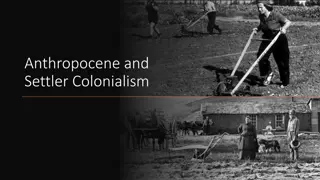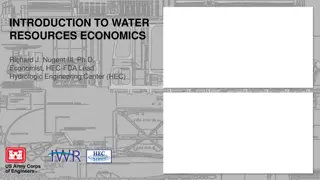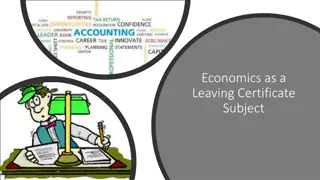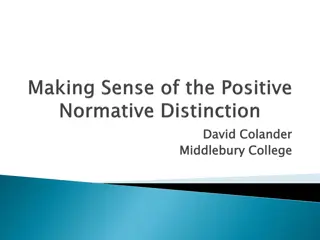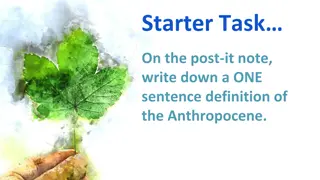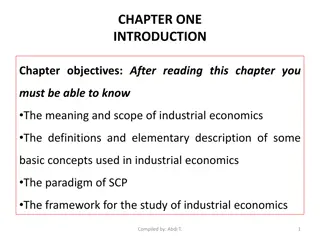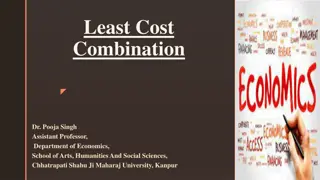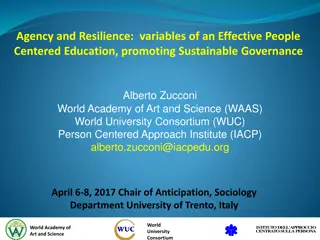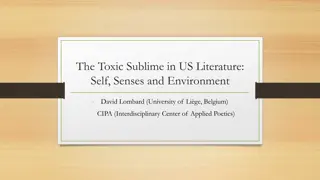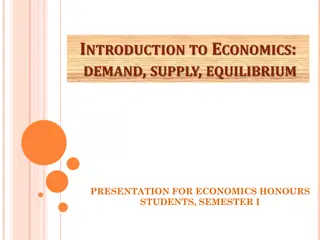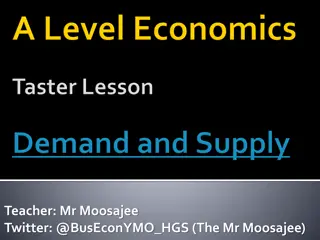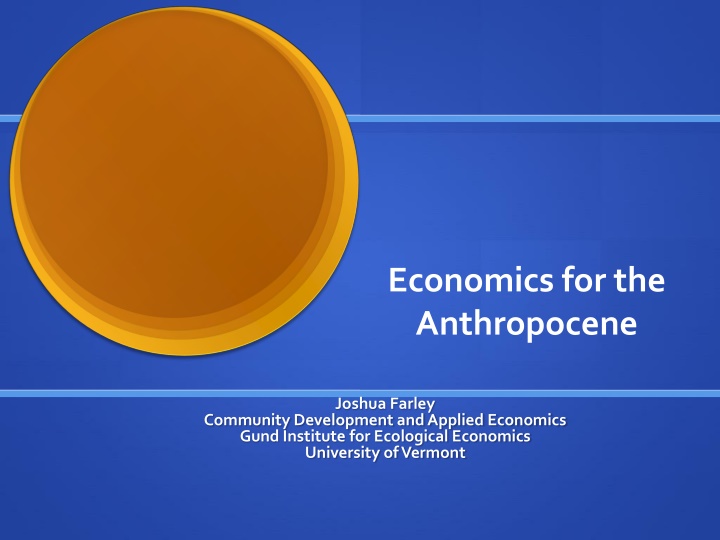
Economies in the Anthropocene Era
Explore the evolution of economies from hunter-gatherer societies to the industrial age, and the shift towards cooperation and sustainability in the Anthropocene era. Learn about the interconnectedness of physical, ecological, and economic systems, and the societal challenges we face in achieving just and sustainable degrowth. Delve into the concept of ecological thresholds, the supply curve, and physiological boundaries in shaping economic and societal choices.
Download Presentation

Please find below an Image/Link to download the presentation.
The content on the website is provided AS IS for your information and personal use only. It may not be sold, licensed, or shared on other websites without obtaining consent from the author. If you encounter any issues during the download, it is possible that the publisher has removed the file from their server.
You are allowed to download the files provided on this website for personal or commercial use, subject to the condition that they are used lawfully. All files are the property of their respective owners.
The content on the website is provided AS IS for your information and personal use only. It may not be sold, licensed, or shared on other websites without obtaining consent from the author.
E N D
Presentation Transcript
Economics for the Anthropocene Joshua Farley Community Development and Applied Economics GundInstitute for Ecological Economics University of Vermont
Economies as Evolutionary Systems Hunter gatherer economies (Pleistocene) Accumulation = death Agricultural economies (Holocene) Emerged simultaneously around the world when climate stabilized Property rights, division of labor, political hierarchy Population density, knowledge, and rate of change
Economies as Evolutionary Systems Industrial economics (Dawn of Anthropocene) Fossil fuels, non-renewables Competition Growth Financial economics (now) Profound change in our lifetimes Price from negative to positive feedback loops Redistribution Information economy and Ecological Economy (emerging) Cooperation and altruism necessary and more efficient
Economies as physical systems Laws of physics Can t make something from nothing Energy required to do work Can t make nothing from something Laws of ecology Raw material inputs into economic production alternatively serve as structural building blocks of ecosystems Removing structure, emitting waste degrades ecosystems Essential life support functions Laws of economics When marginal costs exceed marginal benefits, stop
Societal Challenges in the Anthropocene Just and sustainable degrowth
Ecological Thresholds and the Supply Curve Must sum together all costs: labor, capital, biodiversity loss, nitrogen, climate change, etc. (marginal cost) Economic output (fossil fuel economy)
Physiological Boundaries/Thresholds and the Demand curve Value: Increasing rapidly with decreasing quantity. food security, household security Value: shift from marginal to total value (e.g. diamond-water paradox) physiological threshold: e.g. starvation Value: low and stable Trade-offs: relatively unimportant benefits Opportunity cost Trade-offs: Resilience, increasingly important benefits Trade-offs: Life sustaining benefits Essential resources (social foundation), e.g. calories/day
Societal Challenges in the Anthropocene
Market Solutions Competition, self-interest and choice Preference satisfaction Internalize externalities Make prices reflect full costs Creates incentives for innovation and substitution Preferences weighted by purchasing power Americans spend 6% of income on food for home consumption; ~1% on raw food Many Africans spend 75%; ~ 50% on raw food What happens when prices double? Prioritize preferences or physiological need?
Market Demand curve for essential resources food security, household security physiological threshold: e.g. starvation Rich Middle class Poor Price Food production (in calories/day/capita)
Market Solutions Marginal market costs (Market supply curve) Poor people have no demand
Why markets fail Non-excludability (ecosystems) Lack of laws and institutions, e.g. oceanic fisheries, waste absorption capacity Inherently non-excludable, e.g. climate regulation, protection from storm surges, etc. Only collective ownership is possible Non-rivalry (information and green technology) Physical characteristic Resources not depleted through use; prices create artificial scarcity Optimal price is zero Collective provision is optimal, no ownership Natural monopoly: high fixed cost, low marginal cost
Supply Curve for Natural Monopoly What s the optimal number of firms per industry in an information economy?
Prisoners Dilemmas Global Climate Change Natural resource depletion/biodiversity loss (finite raw material sources, finite services) Innovation in the information age Cooperation is best solution Collective production/protection Collective ownership Counter example?
Can People Cooperate? Stupid question Are people good or evil? Characteristics of an evil person Characteristics of a good person Economics, money and cooperation Bauman Y, Rose E. Selection or indoctrination: Why do economics students donate less than the rest? Journal of Economic Behavior & Organization. 2011;79(3):318-327.; Frank RH, Gilovich T, Regan DT. Does Studying Economics Inhibit Cooperation? Journal of Economic Perspectives. 1993;7(2):159-171.; Kirchg ssner G. (Why) are economists different? European Journal of Political Economy. 2005;21(3):543-562; Vohs KD, Mead NL, Goode MR. The Psychological Consequences of Money. Science. 2006 November 17, 2006;314(5802):1154-1156.
Evolution of Cooperation Genetic Multi-level selection Distribution of pro-social behavior Bacteria, slime-molds, insects, fish, humans (super cooperators) Oxytocin Detecting cheaters Cultural Altruistic punishment Punishing non-punishers Group identity Reciprocity and indirect reciprocity
Economics of Cooperation Alternative energy, cures for pandemics, sustainable food system technologies Values maximized at price of zero Competitive markets create scarcity (production and consumption) Energy transitions produce cultural transitions Myxococcus xanthus, Dictyostelium discoideum and the human predicament Struggle for energy causes violent conflict Cooperation for energy ends violent conflict
Institutions for Cooperation Institutions can make generous people act selfishly, or selfish people act generously Reciprocity or payments? Intrinsic vs. extrinsic motivation Social norms: glorify greed or punish it?
Conclusions Markets emerged simultaneously with fossil fuels Nature of scarce resources has changed from rival, excludable to non-rival and/or non-excludable Cannot transform physical characteristics of resources to fit market model Must transform economic system to resource characteristics, human behavior Prisoner s dilemmas Physiological necessities Cooperation and common ownership

